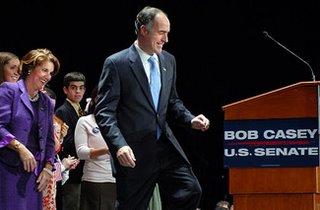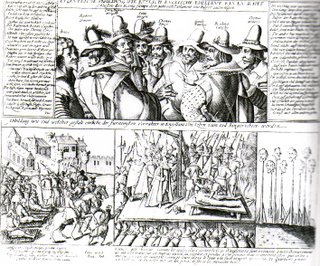 "Longinus" pierces the side of Christ with a lance.
"Longinus" pierces the side of Christ with a lance.Last week, we had the
40 Hours Devotion at my parish. For one of the hours I was there, I was asked by the deacon to read John 19: 31-37, and to offer a reflection.
Hat tip to Crystal and friends at
Friendly Skripture Study for the help.
A reading from the Gospel according to John
Blood and Water…
Now since it was preparation day, in order that the bodies might not remain on the cross on the sabbath, for the sabbath day of that week was a solemn one, the Jews asked Pilate that their legs be broken and they be taken down.
So the soldiers came and broke the legs of the first and then of the other one who was crucified with Jesus. But when they came to Jesus and saw that he was already dead, they did not break his legs, but one soldier thrust his lance into his side, and immediately blood and water flowed out.
An eyewitness has testified, and his testimony is true; he knows that he is speaking the truth, so that you also may come to believe.
For this happened so that the scripture passage might be fulfilled: "Not a bone of it will be broken."
And again another passage says: "They will look upon him whom they have pierced." This reading from John takes place right after Jesus has died on the cross and has handed over His Spirit to the Father. The way I had always looked at it, this prior reading about the death of Jesus had always overshadowed and overpowered the one we just heard.
In the enormity of the impact of the death of Jesus, these matters concerning the breaking of the bones of the legs and the spear being thrust into the side of Jesus may seem like incidental details to the larger story, but the more I looked at it, the more I realized that this passage is loaded with historical and symbolic meaning.
John is stressing the importance of his eyewitness account of events here, an account in which he is registering his amazement that out of this catastrophe, God has taken control of this situation and unveiled His plan and purposes in an unlikely sequence of events.
It seems to me that there are two crucial points that John is putting across in this passage. The first is to emphasize that the death of Jesus was a real, physical, bodily death, which means therefore, that the resurrection was going to be a real, physical, bodily resurrection.
The second point we are to take is that Jesus, the spotless lamb of God, Israel’s suffering servant, has fulfilled all of the old testament scriptures and prophecies regarding the Messiah.
Getting back to the first point, John’s Gospel was written about the year 90 to 100 AD, and at that time there were several Gnostic groups and sects competing with the early Church, who were claiming that Jesus did not have a real physical body, but only a spiritual body, or that he did not really die on a cross, but only appeared to do so. John’s Gospel refutes and dispels that very notion.
Let’s look a bit at the history and the circumstance around what is happening here. Why would the Jewish authorities ask the Romans to break the legs of crucifixion victims? In John’s Gospel the crucifixion takes place on the preparation day for Passover. It was imperative for them that the bodies not be left on the crosses overnight or even after sundown with the Sabbath approaching, for according to the book of Deuteronomy, someone who is cursed by being put to death on a tree cannot be left overnight, or else the land will be defiled.
Breaking the legs of crucifixion victims is meant to hasten death. When the legs are broken, the victim hangs completely by the arms, and the chest cavity bears the full weight the body. The victim can no longer prop himself up by flexing his thighs, and it becomes more and more difficult for the victim to breathe. Suffocation is the inevitable result.
The passage says however, that Jesus was already dead, in fact Pilate was surprised afterwards to hear that he was already dead so quickly, so His legs were not broken. Under the Roman law however, the soldiers were required to certify that the crucified victims were dead, which is the reason why the lance was thrust into the side of Jesus. This is the unusual and unlikely scenario that amazed John in how it fulfilled the Old Testament scriptures.
We see in the book of Exodus, the description of the requirements for the preparation of the Passover lamb, where its says…
“It must be eaten in one and the same house; you may not take any of its flesh outside the house. You shall not break any of its bones.”
..And John refers explicitly in the passage to Psalm 34, which says:
“The LORD is close to the brokenhearted, saves those whose spirit is crushed. Many are the troubles of the just, but the LORD delivers from them all. God watches over all their bones; not a one shall be broken.”
Again, it must be remembered that in John’s Gospel, this is the preparation day for the Passover. At that very time that these events were taking place, those standing on Golgotha could have looked across directly to the Temple in Jerusalem where the Passover lambs were being sacrificed at that very moment. What God has made clear to John is that Jesus has become the Passover lamb – that Jesus IS our paschal sacrifice.
As for the piercing of the side of Jesus, John makes reference to a passage from Zecariah:
“I will pour out on the house of David and on the inhabitants of Jerusalem a spirit of grace and petition; and they shall look on him whom they have pierced, and they shall mourn for him as one mourns for an only son, and they shall grieve over him as one grieves over a first-born.”
The wine, of course, is an emblem for the Eucharist, and the water for our Baptism.
Fully divine, yet fully human as well… What trust Jesus must have had in His father to face such an ordeal. Perhaps it was the faintest glimmer of hope for the disciples that in the face of what seemed to be such a bitter defeat, there were signs that the prophecies that Jesus had spoken of to them were true. John is OUR eyewitness, testifying that these things are true, so that we may believe. Blessed are those who have not seen, but believe.
In those times when we bear our various infirmities, when we feel crushed or abandoned, when our troubles are many, and like Israel’s suffering servant, we set our faces like flint, the LORD delivers us all, and watches over our bones; not a one shall be broken










